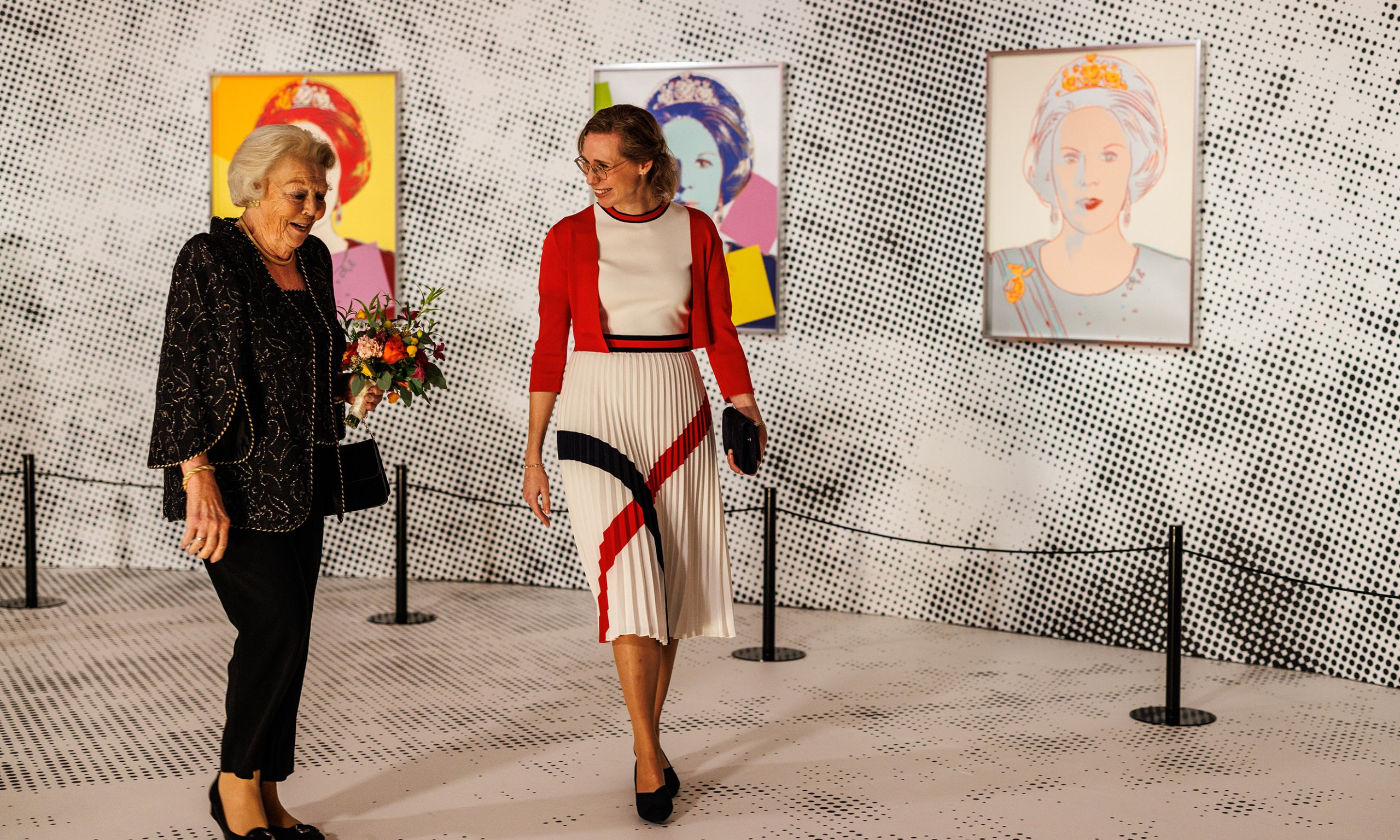Princess Beatrix and the curator Hanna Klarenbeek at the opening of Queens by Andy Warhol at the Paleis Het Loo in Apeldoorn, the Netherlands Photo: courtesy of Paleis Het Loo
In a subterranean gallery, five queens are gathered. Four of them are diamond dust-embellished Andy Warhol screen prints; the fifth is one of the subjects, Beatrix of the Netherlands, here in person. The other three are Elizabeth II of Great Britain, Margrethe of Denmark, and Ntombi Tfwala of what used to be Swaziland, and is now Eswatini.
Princess Beatrix, as she is officially known since her 2013 abdication, has come to the Paleis Het Loo in Apeldoorn—formerly one of her family’s homes, now a museum—to see Queens by Andy Warhol, opening this weekend (12 October-1 January 2025). The idea of exhibiting the 16-piece landmark Warhol series (each queen is portrayed four ways) came to the Paleis Het Loo staff last January, explains the director Frans van der Avert. “It was because of the abdication of Queen Margrethe—this meant none of them were any longer reigning queens.” Elizabeth died in 2022, while Ntombi’s reign as regent ended in 1986 when her son, Prince Makhosetive, became king.
Queen Beatrix Of The Netherlands from Andy Warhol's Reigning Queens (1985) on show at the Paleis Het Loo Photo: courtesy of Paleis Het Loo
The Reigning Queens series was conceived in the early 1980s; Warhol’s dealer, George Mulder, came up with the idea, and then approached the four women who were the world’s only female monarchs, to ask their permission. Beatrix was immediately positive; Elizabeth said she would not stand in his way. Margrethe, who did not approve of Warhol’s lifestyle, was initially hesitant, and Ntombi refused to engage with the idea at all.
“In the end Mulder went to Swaziland and came home with a press photograph, which was used as the basis for the portrait,” says the exhibition's curator Hanna Klarenbeek. The other queens eventually agreed to their official portraits being used as the basis for the project; but Ntombi’s inclusion was against her will.
“Her representative asked Mulder twice not to do it. This is a story we are telling in this exhibition for the first time,” Klarenbeek says. Adding to the insult, Warhol even added an entirely inappropriate feature headdress; Klarenbeek sees the incident as a precursor to a situation all too common in today’s digital age, the stealing of an image and its manipulation in a way the portrait’s owner did not sanction.
Warhol—who said of Reigning Queens that “everybody knows I’m a queen, but the portraits are of Royal ones”—finished the series in 1985, in two editions, one of 40 and the other, of 30, embellished with what he called ‘diamond dust’, tiny particles of sparkly glass. Most of the series has been broken up, and the Paleis Het Loo owns one of only two intact ‘diamond dust’ sets in museum collections—this is the first time it is been exhibited for 25 years. The British Royal Collection, meanwhile, acquired four Elizabeth prints in 2012 for the Diamond Jubilee; they are the collection’s only portraits of the late Queen for which she did not sit.
Meanwhile, the story of the world’s real-life reigning queens is that after Marguerite stepped down in January there were, for a while, none at all. But last month Nga wai hono i te po was anointed Māori Queen of New Zealand. And waiting in the wings in Europe are Princesses Catharina-Amalia of the Netherlands, Leonor of Spain, Victoria of Sweden and Elisabeth of Belgium.

